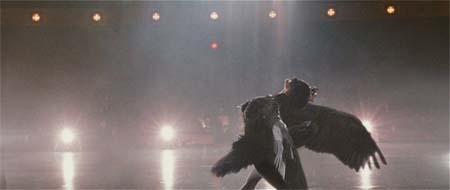“I think it was probably the strangest script I ever read.”–Robert Downey Jr.
“I was very confused by the script at first, it’s a bizarre kind of story…”–Woody Harrelson

DIRECTED BY: Richard Linklater
FEATURING: Keanu Reeves, Robert Downey Jr., Winona Ryder, Woody Harrelson, Rory Cochrane
PLOT: In the near future, an estimated twenty percent of the American population is addicted to a drug called “Substance D.” “Fred,” an undercover agent, is posing as Bob Arctor, hanging out with a small-time group of users, hoping to locate a high level supplier. Fred, who is becoming more and more addicted to substance D and is being watched closely by police psychologists concerned about possible brain damage, grows increasingly paranoid, especially when one of Arctor’s roommates goes to the police and accuses the plant of being a terrorist.

BACKGROUND:
- Philip K. Dick (1928-1982) was a fascinatingly weird figure, a counterculture science fiction author and the man responsible for the stories that were adapted into movies like Blade Runner, Total Recall, Minority Report, and others. He was also a heavy user of amphetamines (and, some say, LSD) in his youth; in his later years he became paranoid, and may in fact have been living with some form of mental illness. In 1974, after taking sodium pentothal for an impacted wisdom tooth, Dick began seeing visions involving pink beams of light, the sense of having lived a previous life as a persecuted Christian in the Roman era, and communication from a super-rational intelligence he dubbed “VALIS.” To Dick’s credit, he never surrendered to these delusions altogether; he remained rational enough to write coherent (if paranoid) novels.
- Dick’s novel “A Scanner Darkly” was written in 1977 and set in 1992. It was based on the author’s own experiences as a drug addict, and was dedicated to casualties of drug abuse (the author’s roll call of those “punished entirely too much for what they did” is included before the movie’s end credits).
- Charlie Kaufman wrote an unproduced adaptation of “A Scanner Darkly,” and Terry Gilliam was also reportedly interested in the property.
- The animation technique used here is rotoscoping, where actual footage is filmed and then “painted” over by animators (in this case, with the aid of computer software, although in the earliest days of the technique a team of artists would hand-paint each individual frame of film).
- Filmed in a brisk 23 days, but post-production (i.e. the rotoscope animation) took 18 painstaking months to complete.
INDELIBLE IMAGE: The “scramble suit,” the undercover cloaking device of the future which is “made up of a million and a half fractional representations of men, women and children.” These “fractional representations” flicker across the surface of the suit, masking the the wearer’s identity by changing him into a “vague blur” of constantly shifting identities. The effect is eerie and disorienting, but unforgettable.
THREE WEIRD THINGS: Aphids everywhere; scrambled identities; alien presiding at a suicide
WHAT MAKES IT WEIRD: A Scanner Darkly is a paranoid, dystopian meditation on self-destruction—both personal and social—told as a sci-fi parable about an addictive, mind-rotting hallucinogen. For extra weirdness, the entire movie is rotoscoped to create a squirmy, synthetic reality.
Original trailer for A Scanner Darkly
COMMENTS: Hollywood has long been attracted to the works of Continue reading 235. A SCANNER DARKLY (2006)






